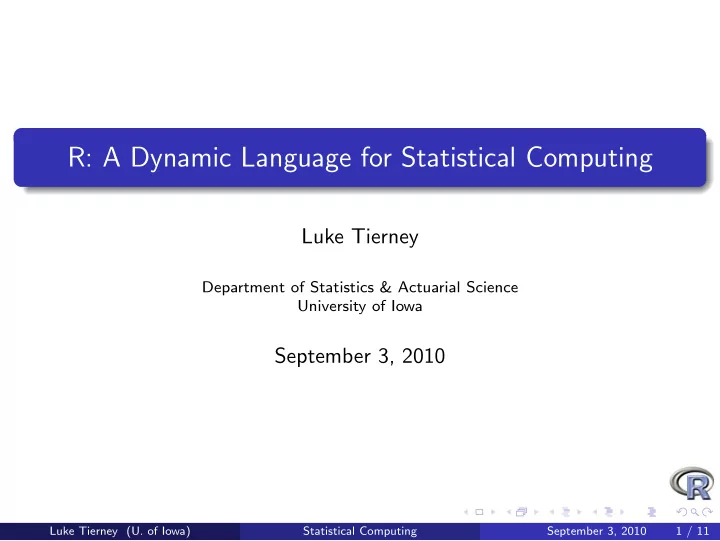

R: A Dynamic Language for Statistical Computing Luke Tierney Department of Statistics & Actuarial Science University of Iowa September 3, 2010 Luke Tierney (U. of Iowa) Statistical Computing September 3, 2010 1 / 11
Introduction R is a language for data analysis and graphics. Originally developed by Ross Ihaka and Robert Gentleman at University of Auckland, New Zealand. Now developed and maintained by a distributed group of 19 people. R is based on the S language developed by John Chambers and others at Bell Labs. R is widely used in the field of statistics and beyond, especially in university environments. R has become the primary framework for developing and making available new statistical methodology. Most extension packages are available through CRAN or similar repositories. Luke Tierney (U. of Iowa) Statistical Computing September 3, 2010 2 / 11
The R Language R is a dynamic language. Lazy evaluation is used for function arguments. everything is a function, including flow control sometimes used to capture argument expressions and evaluate in non-standard ways Managing data is an important part of the language. Typical usage is initially interactive read some data into variables make some plots compute some summaries more sophisticated modeling steps develop simple functions to replicate analysis ... Luke Tierney (U. of Iowa) Statistical Computing September 3, 2010 3 / 11
The R Language (cont.) R is a vector/array language similar in some ways to MATLAB, APL if x is a vector of data then (x - mean(x)) / sd(x) produces a standardized version. Explicit looping is often unnecessary. Writing loops can be necessary/convenient at times. The current interpreter is rather slow, making explicit loops using scalar-sized values slower than in should be. R packages can include code written in C or FORTRAN to improve performance to allow use of existing code implementations Luke Tierney (U. of Iowa) Statistical Computing September 3, 2010 4 / 11
Parallel Computing in R R is single-threaded. Two approaches have been used to add parallel computation: explicit parallel computing by creating separate communicating R processes (e.g. snow, Rmpi) implicit approaches, including using a multi-threaded BLAS parallelizing vectorized operations and matrix/array operations using OpenMPI (e.g. pnmath) There is also work on using GPU-based parallel computing within R packages. Luke Tierney (U. of Iowa) Statistical Computing September 3, 2010 5 / 11
Some Directions for the R Engine Some directions I hope to work on in the next 12 to 18 months: Adding parallelized versions of for vectorized operations and simple matrix operations to the core distribution. Byte code compilation of R code. Increasing the limit on the size of vector data objects. Luke Tierney (U. of Iowa) Statistical Computing September 3, 2010 6 / 11
Parallelizing Vector and Matrix Operations Conceptually, vectorized math functions are easy to parallelize. Parallelizing loops for short vectors will often slow the code down. Break-even points vary with hardware/operating system. A strategy for determining and using break-even points is needed. A preliminary implementation is available as the pnmath package. Basic issues carry over to simple matrix operations, like colSums, and operations producing matrix results from vectors, like dist. Being able to easily turn off parallel computation may be important to avoid contention in explicit parallelization contexts. Luke Tierney (U. of Iowa) Statistical Computing September 3, 2010 7 / 11
Byte Code Compilation The current R implementation parses code into a parse tree when the code is read evaluates code by interpreting the parse trees. Compiling to byte code for a suitable virtual machine should improve performance help enable further improvements Efforts to add byte code compilation to R have been underway for some time. Current R implementations include a byte code interpreter, and a preliminary compiler is available from my web page. The current compiler and virtual machine produce good improvements in a number of cases. However, better results should be possible with a new virtual machine design. This redesign is currently in progress. Luke Tierney (U. of Iowa) Statistical Computing September 3, 2010 8 / 11
Byte Code Compilation (cont.) The new virtual machine will support avoiding the allocation of intermediate values when possible more efficient variable lookup mechanisms more efficient function calls possibly improved handling of lazy evaluation Other directions to explore include opcode fusing for parallelization declarations (sealing, scalars, types, strictness) advice to programmer on possible inefficiencies machine code generation using LLVM or other toolkits replacing the interpreter entirely Luke Tierney (U. of Iowa) Statistical Computing September 3, 2010 9 / 11
Byte Code Compilation (cont.) A simple, artificial, example: p1 <- function(x) { for (i in seq_along(x)) x[i] <- x[i] + 1 x } In R this is essentially equivalent to x + 1 . Some timings for x <- rep(1, 1e7) on an x86_64 Ubuntu laptop: Method Time Speedup Interpreted 32.730 1.0 Byte compiled 9.530 3.4 Experimental 1.128 29.0 0.119 275.0 x+1 Luke Tierney (U. of Iowa) Statistical Computing September 3, 2010 10 / 11
Increasing the Limit on the Size of Vector Objects Currently The total number of elements in a vector cannot exceed 2 31 − 1 = 2 , 147 , 483 , 647 This is fairly large, but is becoming an issue with larger data sets with many variables on 64-bit platforms. Can this limit be raised without breaking too many existing packages requiring the rewriting of too much C code? breaking compatibility with external software, such as BLAS breaking ability to handle saved work spaces across platforms Possible directions: changing the integer data type adding a long integer data type allowing floating point numbers to be used for length and index calculations. Luke Tierney (U. of Iowa) Statistical Computing September 3, 2010 11 / 11
Recommend
More recommend